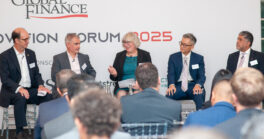Fergus King is vice president of global supply chain for consumer products at TomTom, a mapping and geolocation-technology specialist. He offers an insider’s view of the semiconductor shortage, explaining why small brands get short shrift and reshoring doesn’t work.

Global Finance: How has the supply chain crisis impacted your company?
Fergus King: While in recent years TomTom has pivoted to software, maps and location technology, it continues to manufacture and sell personal navigation devices—although in much smaller volumes than in the past. These devices are manufactured in China by a Taiwanese company.
The shortages in consumer electronics are a result of Covid-19 kicking in, factories shutting down and then reopening with significantly increased demand. That sequence highlighted capacity limitation in semiconductor manufacturing. In October, for example, we are likely to receive just 30% of the components we need to meet our inventory requirements.
GF: What measures has the company taken to address these challenges?
King: One strategy we have adopted to maintain activity is to buy common components on the gray market. But for unique components such as semiconductors there is no alternative. Semiconductor manufacture is the critical bottleneck: There are only a few companies in the market, and you just wait for your turn. That turn may not necessarily be determined by when you place your order. Any manufacturer wants to serve its biggest and most profitable customers first, although longevity of relationship is also important. Everyone is paying more; but even if you offered double or treble the price, you wouldn’t necessarily get further up the queue.
GF: What other factors determine when, or whether, semiconductor orders are met?
King: The technology being deployed matters in semiconductors. Manufacturers obviously want to squeeze as much profit as possible out of production. It might be possible to get 200 chips out of a single wafer with a 5-year-old design. But it might be possible to get 400 chips of a brand-new design out of that same wafer. The manufacturing time is the same in both cases; but the new chip sells for a higher price, and they can make more of them. Customers needing older chip designs are inevitably less of a priority. Smaller brands tend to suffer most.
GF: How have pricing and lead times changed?
King: Some semiconductors have doubled in price, but overall costs are up by 15%-20% over the past year. Semiconductor manufacturers are trying to limit price increases; but wafer prices are going up, and they cannot absorb it all. To date, we’ve not passed on these price rises to customers; but our margins have been squeezed dramatically, and we will not be able to maintain this forever.
In the past, the longest lead time we had was 12-16 weeks for central processing units and glass; now it is up to 52 weeks. One manufacturer of chips is unable to tell us when we can have our order. As a result, our engineers are likely to have to redesign circuitry so we can substitute an alternative chip.
GF: Have current logistics problems affected TomTom?
King: As we manufacture in China, we face reduced freight capacity and increased costs. As our products are high value, we airfreight most of them. Airfreight used to have a three- or four-day lead time. Because of Covid, we now assume 10 days for airfreight and sometimes can’t get on a flight. So far, our road distribution in Europe has not experienced any major disruption, although prices are going up as fuel costs increase.
GF: Has TomTom considered reshoring?
King: Five years ago, we felt too reliant on China and investigated moving production to elsewhere in Asia or to Eastern Europe. Our analysis showed that labor costs were broadly similar in Eastern Europe, for example; and there were savings on logistics. But crucially, most of the electronic components would still have come from Asia; and therefore overall, a shift was not viable. In the longer term, the US and the EU should be trying to build semiconductor fabrication plants so that they’re not reliant on Asia. The US now recognizes this; the EU also needs to do so.



